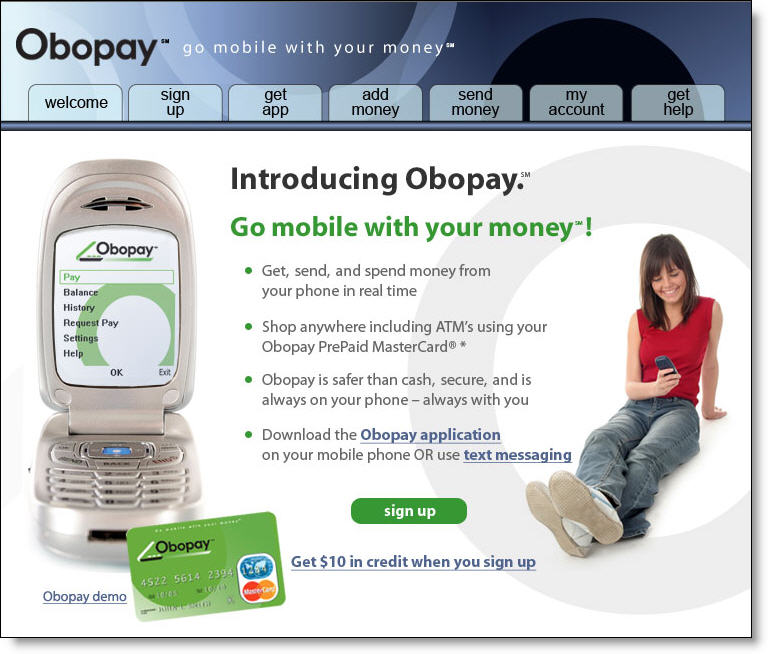 One of the better overviews of mobile payments appeared in the Wall Street Journal several months ago (April 26). It looked briefly at TextPayMe, Obopay (see screenshot below) and PayPal Mobile (NB June 5). The article does a good job of contrasting these systems to the more common "mobile wallet" where a cellphone is used in place of a credit/debit card.
One of the better overviews of mobile payments appeared in the Wall Street Journal several months ago (April 26). It looked briefly at TextPayMe, Obopay (see screenshot below) and PayPal Mobile (NB June 5). The article does a good job of contrasting these systems to the more common "mobile wallet" where a cellphone is used in place of a credit/debit card.
Analysis
While we see much promise for the mobile wallets, the mobile payment feature appears far less useful, at least in the United States.
Mobile Wallets: It's inevitable that today's plastic-based payments systems morph into cellphone-based services using radio frequency (RFID) technology as the enabler. For many people, especially younger cellphone-toting, debit-card users, it will be easier to point their phone at the POS terminal and press # than to swipe a card and enter a PIN or sign a receipt. Arthur D. Little projects $37 billion in mobile wallet transactions in 2008, a twelve-fold increase from the $3 billion in 2003.
And for those who don't carry a cellphone, or who prefer a different access device, companies are working on RFID-enabled watches, jewelry, key chains, and something Citibank is said to be preparing for market later this year, an RFID money-clip, which I'd love to use, although I've yet to see a contactless point-of-sale location in Seattle (see, "Creating the Perfect Mobile Wallet," NB June 7).
 Mobile Payments: On the other hand, text-message-based services, designed to send money to individuals, are a solution seeking a problem. As cool as they look on a well-crafted homepage (see Obopay's homepage right), there just isn't enough payoff for changing deep-seated consumer payment habits.
Mobile Payments: On the other hand, text-message-based services, designed to send money to individuals, are a solution seeking a problem. As cool as they look on a well-crafted homepage (see Obopay's homepage right), there just isn't enough payoff for changing deep-seated consumer payment habits.
Even the WSJ couldn't dig out a rational anecdotal example, though the writer tried. The usual "splitting the dinner bill" straw man was trotted out, but upon closer look, too many variables could make it unworkable. Imagine you had a group splitting a $100-tab four ways. The vendors want us to believe that one person will pay the entire bill, then his or her three friends will each text-message their $25 share. Outside of Silicon Valley and a few Manhattan neighborhoods, it just won't fly.
It is not only a hassle (what if the phone call is disconnected, or the wrong button is pushed in a dark eatery), but also each of the three parties will likely incur one or more transaction fees (from the payments gateway, the cell phone provider, and possibly one or more financial institutions along the way). Finally, the person receiving those payments then has to initiate some type of transaction to tap the $75 sitting in their account.
This makes about as much sense as ordering dog food online. Current methods of sharing costs, either with cash, having the restaurant apply it to two or more debit/credit cards, or by agreeing to "get the next one" works just fine.
–JB